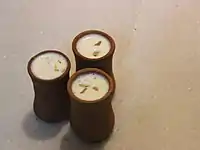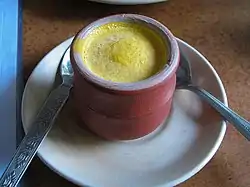Matki (earthen pot)
Matki (or matka) is a Hindi word used for an earthen pot. It is used all over the Indian subcontinent, as a home "water storage cooler". It has been in use since ancient times and can be found in houses of every class.



Production
They are made by the combination of two types of mud clay: the first is taken from the surface of the earth and the second after digging more than 10 feet deeper into the earth. Making a matka takes a considerable amount of time. It is a long process of at least 8 days. The clay is mixed with water, shaped, finished, polished, dried and baked in a kiln for 5 days. At last it becomes a completed eastern earthen pot, a home water cooler. In current times, in India, the earthen pots have undergone change, with taps being attached for people's convenience.[1]
Cooling process
The cooling process works through evaporative cooling. Capillary action causes water to evaporate from the mini-pores in the pot, taking the heat from the water inside, thus making the water inside cooler than the outside temperature. Hence it is used only during summer and not in winter.
Gallery
 A matka (big earthen pot) on roadside at Chinawal, India.
A matka (big earthen pot) on roadside at Chinawal, India. Indus Valley Civilization pot from Harappan phase found at Quetta in Baluchistan, c. 2500-1900 BC, displayed at Royal Ontario Museum.
Indus Valley Civilization pot from Harappan phase found at Quetta in Baluchistan, c. 2500-1900 BC, displayed at Royal Ontario Museum. Clay pots in Punjab in Pakistan.
Clay pots in Punjab in Pakistan.
See also
References
- "Good old earthen pots , with a modern touch". Thehindu.com. 29 April 2014. Retrieved 8 September 2018.